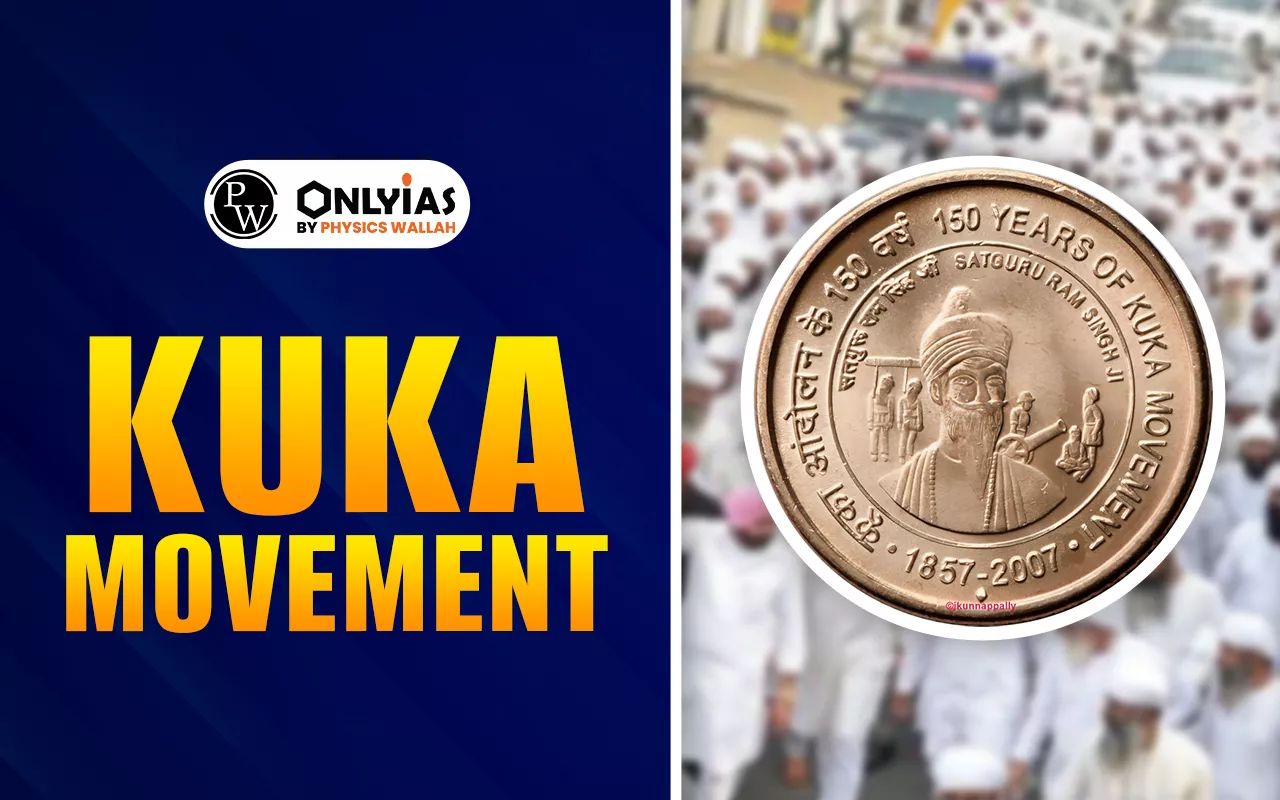The Kuka Movement, also known as the Namdhari Movement, was a 19th-century Sikh reform and resistance movement in Punjab led by Baba Ram Singh, promoting religious purity, social equality, and defiance against British rule. Emerging in 1857, it laid the foundation for future Indian freedom struggles through its ideals of self-reliance, non-cooperation, and moral discipline.

Kuka Movement, or Namdhari Movement, was an important socio-religious rebellion in Punjab in the 19th century. The essence of the Kuka Movement is illustrative of Sikh reformist movements of the late 19th century onwards. Starting in 1857 with Baba Ram Singh to regenerate Sikhism, and to resist the British, it was based on ideals of a pure form of Sikhism. The focus within a Kuka ideology was on reforming society within the British establishment – for example, caste discrimination, encouraging widow remarriage, and opposing the consumption of alcohol and meat.
As Kuka ideology and individuals began to take political action against the British, however, the focus was on overthrowing British power, to boycott foreign goods, education, and other daily activities. By the peak period of 1872, facing retaliatory violence and imprisonment under the British, the Kukas engaged in violent uprising against British forces, facing extreme retaliation themselves and suffering great loss and injury. The Kuka Movement, in its essence, mirrors contemporary Indian independence movements that followed “the end of Empire”.
Kuka Movement was organized by Baba Ram Singh in 1857, inspired by earlier Sikh reformers like Baba Balak Singh. Its roots trace back to the northwestern parts of Punjab during a time of great political upheaval—the fall of the Sikh Empire in 1849 and subsequent British annexation. The term “Kuka” came from the followers’ distinctive way of chanting “Gurbani” (Sikh hymns) in a high-pitched voice, called “kook” in Punjabi. Also referred to as the Namdhari Movement, the movement focused on reviving Sikh religious customs, emphasizing purity and simplicity in practice.
The greatest leader of the Kuka Movement was Baba Ram Singh, who helped to motivate the Sikh community to revert to their original spiritual and social values. He urged his followers, such as Jagjit Singh and other influential leaders, to disseminate the message of self-discipline, non-violence, and opposition to British policies. Under the guidance of Baba Ram Singh, the kukas were led to live strict lives, such as vegetarianism, alcohol and tobacco abstinence, wearing of hand-spun white clothes, which is a symbol of purity and self-sufficiency.
Kuka Movement was officially commenced back in 1857, when there was major resistance against the British rule in India. At first, it was a religious reformation movement, but it took on political goals gradually, particularly after the Great Revolt of 1857.
The height of the movement was about 1872 when adherents battled the Britons in armed conflicts throughout events such as the Kuka raid on Malerkotla, where the followers were met with harsh retaliation. Even after Britain suppressed it, the movement had an enduring effect on Sikh identity and anti-colonialism.
Kuka Movement had several clear objectives that combined social, religious, and political reform.
Check Out UPSC CSE Books
Visit PW Store
Kuka Movement’s focus on self-sufficiency and a boycott of foreign imported goods were precursors to later Swadeshi movements in the early build-up to India’s independence movements. Their social reforms led to questioning entrenched social norms—such as caste privileges and gender roles—and set the stage for progress in equality in the future. The courage and discipline of people associated with the movement motivated later generations in Punjab to take up the banner of Freedom. Although the British meted out severe retribution to Kuka followers—including the execution of a significant number of them, as well as the deportation of Baba Ram Singh—the Kuka Movement still stands as a symbol of resilience and struggle for justice.
Ready to boost your UPSC 2026 preparation? Join PW’s UPSC online courses today!
The Kuka Movement, also called the Namdhari Movement, was a mid-19th-century Sikh socio-religious reform aimed at purifying Sikhism and resisting British rule. It is important for its role in social reforms and early nationalist resistance in Punjab.
The movement was organized by Baba Ram Singh in 1857, who led efforts to revive Sikh religious purity and oppose British colonial policies.
The Kuka Movement started in the year 1857, during the period of anti-British uprisings across India.
The objectives included restoring Sikh religious practices, abolishing caste discrimination, promoting widow remarriage, and boycotting British goods and institutions to fight colonial rule.

<div class="new-fform">
</div>